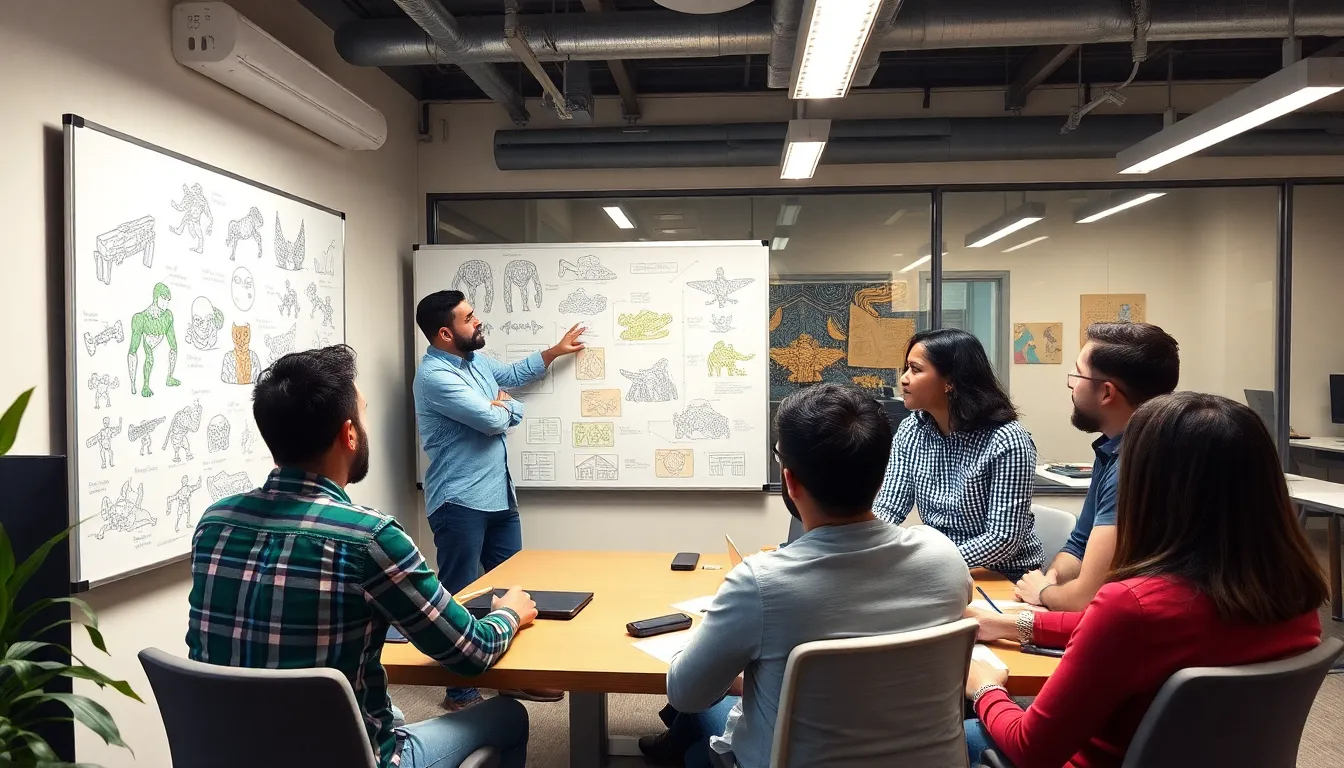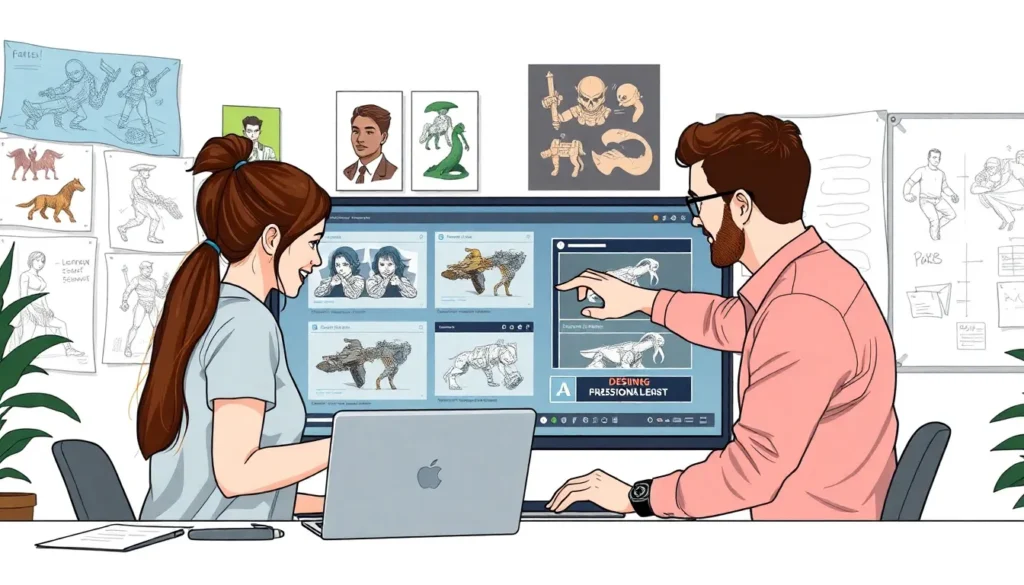Game development isn’t just about slapping together pixels and code; it’s a thrilling journey filled with creativity, challenges, and a whole lot of caffeine. From the initial spark of an idea to the final launch, each stage of development is crucial. It’s like baking a cake—skip the eggs, and you’ll end up with a crumbly disaster instead of a delicious masterpiece.
Overview of Game Development
Game development consists of various stages, each contributing significantly to the overall process. Initial concept development sets the foundation, where ideas take shape and game mechanics are outlined. Following this stage, pre-production begins, focusing on refining the concept and planning resources needed for development.
During production, artists, programmers, and designers collaborate to bring the game to life, creating visuals, audio, and gameplay systems. This stage can vary greatly in duration, depending on the complexity and scale of the project. Key elements include level design, character modeling, and animation.
Testing becomes critical once the game reaches a playable state. Quality assurance teams systematically identify bugs and ensure balanced gameplay. Feedback from testing phases can lead to necessary adjustments, improving the user experience.
Post-production involves preparation for launch. Marketing strategies are developed to reach the target audience, along with finalizing packaging and distribution channels. Monitoring the market response plays a vital role in this phase.
Continual updates and support may follow launch, especially for online or multiplayer games. This ongoing process ensures player satisfaction and often includes content expansions or bug fixes, enhancing the overall game longevity.
Throughout these stages, coordination among teams is essential for a successful product. Each phase builds upon the previous one, much like layers in a cake, culminating in an engaging final experience for players.
Pre-Production

Pre-production serves as a critical foundation for game development, encompassing the initial phases of concept development and comprehensive planning. This stage ensures that the game aligns with the creative vision while effectively planning resources.
Conceptualization
Conceptualization involves brainstorming game ideas, mechanics, and themes. Developers outline the core gameplay and narrative, determining the audience’s target. Ideas evolve through discussions and collaborative sessions. Clear documentation of concepts aids communication among team members. Concept sketches and prototypes often emerge during this process, providing a tangible direction. This phase helps identify the game’s unique selling points and potential challenges, guiding future development efforts.
Planning and Design
Planning and design solidify the project roadmap. Teams create detailed schedules, outlining milestones, resource allocation, and budget estimates. Defining roles for artists, programmers, and designers streamlines collaboration. Game design documents emerge as essential tools that capture gameplay mechanics, art styles, and technical specifications. Prototyping encourages early feedback, allowing developers to refine features. Establishing timelines ensures the team remains focused, minimizing risks during the production phase. This strategic approach to planning lays the groundwork for a successful development process.
Production
Production is a critical phase in game development, where concepts transform into playable experiences. This stage involves collaboration among various teams, ensuring that the game vision comes to life.
Game Design
Game design establishes gameplay mechanics and player experiences. Designers create detailed game rules and player interactions. They develop prototypes that allow testers to experience early iterations. Continuous feedback plays a significant role in refining game elements. Designers often collaborate with both artists and programmers to ensure cohesive integration of ideas.
Art and Asset Creation
Art and asset creation breathe life into the game. Artists produce characters, environments, and animations that define the visual style. Asset creation includes designing textures, models, and user interfaces. Collaboration with designers ensures that aesthetic choices align with gameplay mechanics. This iterative process often involves revisions based on team feedback and technical constraints, ensuring visual elements enhance the overall experience.
Programming
Programming is the backbone of game functionality. Coders implement gameplay mechanics, AI behavior, and user interfaces. They work closely with designers to ensure mechanics translate into engaging experiences. Optimization becomes important to maintain performance across different devices. Frequent testing by developers helps identify and resolve technical issues early, facilitating a smoother development process.
Testing
Testing is an essential phase in game development that ensures a polished and enjoyable experience for players. This stage focuses on identifying and resolving issues before the game reaches the market.
Quality Assurance
Quality assurance (QA) encompasses a systematic approach to finding and fixing bugs. Teams run various tests on gameplay mechanics, graphics, and user interfaces. QA ensures that gameplay remains balanced and free from glitches, which keeps players engaged. Rigorous testing preserves the integrity of the game while optimizing performance on multiple platforms. Common QA methods include functional testing, regression testing, and compatibility testing.
User Testing
User testing gathers feedback from actual players, guiding the development team in refining gameplay. During this process, players engage with the game and share their experiences. Observing how players interact highlights areas for improvement in controls, pacing, and user experience. Incorporating user feedback helps address player concerns and enhances overall satisfaction. Developers often iterate on designs based on the insights gained from user testing sessions.
Launch
The launch stage marks a critical moment in game development. Successful execution relies on comprehensive marketing strategies and efficient release management.
Marketing Strategies
Effective marketing strategies play a vital role during the launch phase. Developers often utilize social media platforms, influencer partnerships, and targeted advertising to create buzz. Engaging trailers and behind-the-scenes content help showcase gameplay and story elements. Email campaigns target interested audiences, while press releases communicate key information to gaming media. Pre-launch events build anticipation by allowing players to interact with the game through beta testing platforms. Collaboration with popular streamers amplifies outreach, attracting potential players leading up to release.
Release Management
Release management ensures a smooth launch for the game. Coordinating the launch date involves evaluating market trends and competitor releases. Developers prioritize scheduling across various platforms, ensuring the game is accessible to a broad audience. This stage also involves finalizing distribution channels, such as digital storefronts and physical retail partnerships. Tracking performance metrics post-launch is crucial for understanding player engagement and sales. Adjustments may occur based on user feedback, guiding future updates and enhancing the overall experience. Each element of release management contributes to sustained player satisfaction and longevity of the game.
Post-Launch
Post-launch marks a significant phase in game development, allowing developers to enhance the player experience after release. It involves ongoing support and fostering player communities.
Updates and Patches
Updates and patches play a crucial role in maintaining a game’s quality. Developers release these enhancements to address bugs, improve performance, and introduce new features. Regular updates keep the game fresh and engaging. For instance, a popular title might receive a patch that adjusts gameplay mechanics based on player feedback. Immediate fixes can prevent issues from impacting player satisfaction. Ensuring compatibility with various devices remains essential, as it helps maximize the game’s reach. Scheduled updates can also build anticipation within the community, keeping players engaged over time.
Community Engagement
Community engagement strengthens relationships between developers and players. Actively communicating through social media platforms fosters a sense of belonging. Developers often create forums or Discord servers where players can share feedback, report issues, and discuss strategies. Engaging in conversations demonstrates a commitment to improving the game based on player input. Hosting events, such as contests or Q&A sessions, encourages participation and builds loyalty. Gathering insights from the community helps developers understand what players enjoy most. Prioritizing this feedback can drive future updates and expansions, ensuring the game evolves with its audience.
Conclusion
Game development is a dynamic and intricate journey that requires careful planning and collaboration across multiple stages. Each phase plays a crucial role in transforming an initial concept into a captivating player experience. From refining ideas during pre-production to ensuring quality through testing and post-launch support, developers must remain adaptable and responsive to player feedback.
The ongoing relationship between developers and their community is vital for a game’s success. By embracing continuous improvement and fostering engagement, developers can keep their games relevant and enjoyable long after launch. Ultimately, the stages of game development work together to create immersive experiences that resonate with players and stand the test of time.



